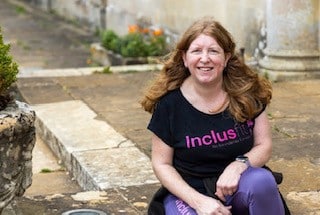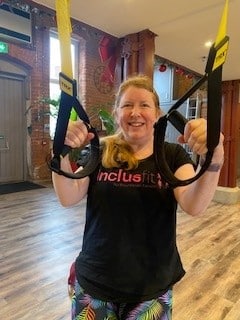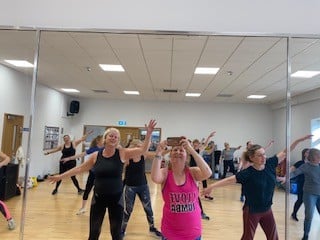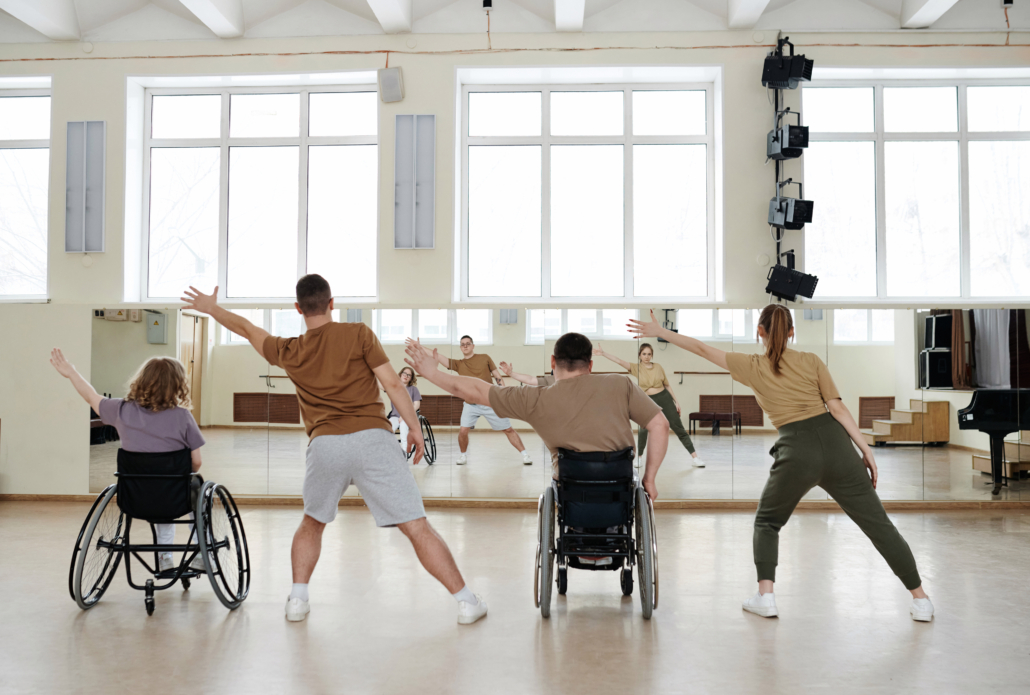Last Updated on September 17, 2025 by Arun
This National Inclusion Week, Sam James, an award-winning disability fitness specialist with Cerebral Palsy, shares her journey and insights on how the fitness industry can become more inclusive and accessible for all.
This National Inclusion Week, we sat down with Sam James – an award-winning disability fitness specialist with Spastic Diplegia Cerebral Palsy – who has spent the past 12 years breaking barriers in the fitness industry.
From qualifying through Instructability to teaching 12 classes a week, working as a Neuro PT, and leading Swindon’s Limitless cycling sessions, Sam is on a mission to make mainstream fitness accessible to everyone.
Her work on industry focus groups and her recognition in the final Disability Power 100, where she placed 2nd in Sport, Health and Wellness, highlight her impact, but for Sam, it’s all about ensuring every disabled person has the right to move, train, and thrive in inclusive spaces.
To start, Sam, can you share how you first got into group exercise instruction, and what drew you to it?
I was watching This Morning when Zumba first came to the UK & they had Beto on. I instantly wanted to try a class.
All I ever wanted to do when I was growing up, was learn to dance and dance but was never given any opportunity to do so by dance schools in my area. I went and tried a Zumba class and absolutely loved it. I was going to a class at every opportunity.
I then cracked a bone in my shoulder joint and through the rehab, I was asked why I didn’t do it as a job. Asked what qualifications I needed to train. Which is where I found Instructability. Within 4 months I qualified with my L3 disability qualification in tow and shortly after I did my Zumba training.
After covering classes, I got given my 1st class and 11.5 years on I am still teaching this class within a community leisure centre. I love the social element of group exercise and often wondered why I was always the token disabled person.
I found that there were separate classes for disabled people. This would horrify me as why would one population group in society be segregated from mixing with everyone else. All disabled people have the right to go to a mainstream fitness class and do it their way. All my classes are open to all and everyone is welcomed with open arms.
As an instructor with a disability, are there any common misconceptions about your classes that you would like to address or clarify?
Yes, a lot of people think I only teach disabled people or I only teach sat down. Yes I have a physical disability, but that doesn’t stop me from actively teaching a class. Most of my classes I teach every day, I teach people stood up and I absolutely love it.
What strengths or unique approaches do you bring to the studio as an instructor with lived experience of disability?
I have had feedback that my verbal cueing is spot on, and I can get all of my participants to do a move without actually demonstrating it. This is because I cannot demonstrate every single move. This also meant when I came back from my back injury, I taught seated by just verbally telling them what to do.
I also have found I attract those with a disability / long term health condition, as I fully understand and get what it is like to move with a disability. I fully know how to adapt without making it look obvious or giving 1 person a completely different move. What’s right for one person, isn’t right for another.
I have given disabled people the chance to be able to exercise and given them the confidence to go on and try other things.
You contributed a fantastic case study to our EMD UK social value report about how you helped Debbie get active and involved in group exercise.
From your perspective, what role do instructors play in creating the supportive community that keeps people coming back?
Instructors play a key role that gets people to come back. Its not so much the class but the instructor themselves that people go for. Friendliness, approachable, fun, able to banter and not take themselves too seriously along with simple, effective choreography helps people come back and keep returning.
I know with Debbie, all of this kept her returning and now we continue the mid class banter every week. Which not only does she enjoy, but the rest of the class enjoy too.
You can find out more about Debbie’s case study by downloading the EMD UK report on the Social Value of Group Exercise here.
I have created a community with all my classes, I have a WhatsApp group for each class, and many have made new friends by coming and supporting each other through good and bad times. This is the true essence of group fitness classes.
How do you help participants of all abilities feel confident in a class with very different fitness levels?
I encourage movement within their own abilities, fitness levels etc. I always tell them in their first class, as long as they are moving, I don’t care what way, if they are coordinated or not. This always puts them at ease.
As an instructor, I never demonstrate the high impact options. Often, I can’t as I’m unable too. But if an instructor is always demonstrating the high impact moves especially before the low impact moves, then the participants are going to feel that they have to do those moves.
If I have a newbie in class, I always stick to the lower impact moves so they feel successful in their first class. It is their workout after all, not mine.
What was it like to return to teaching after your back treatment, and what advice would you give to someone returning to exercise after treatment, surgery, or injury?
I was off work for 6 months with a L5/S1 disc bulge / Sciatica. It was so bad, I couldn’t even walk at one point. I honestly thought my teaching days was over.
But, thanks to the best spinal consultant, I returned after 6 months. I had to teach sitting down to start with, with bringing one class back at a time as I was still having physio. But, I cannot describe how good it was to be back in the studio. I got me back.
Being at home for that long with only seeing a few friends, really gets you down. I wasn’t me at all and you honestly do find out who your true friends are, when something like this happens.
So, to be back in the studio, I felt like me again. To see people and talk to people was so good. I was also made redundant from my day job, so being back, doing what I loved seriously helped with my mental state with everything I had going on. It had relit the fire and passion in me. I have come back stronger than ever and teaching the most classes I’ve ever taught.
My advice to others is listen to your body, stop and rest. If you run yourself and body into the ground, then you are going to struggle with teaching. Get professional help, listen to everything they say and do what they tell you.
If rehab after an injury or surgery, listen and do as the professionals say. It will help you in the long run. I was gutted every time my specialist told me that I couldn’t go back to work yet and needed to work on something more. And I did and, now 2 years on, I’m very thankful I did listen to him and his knowledge.
What changes would you love to see in the fitness industry to better support instructors with disabilities and why do you feel now is the time for that change?
Fitness managers / gyms need to look past the disability and at the potential of the person directly. Disabled people make the most loyal employees. Often never given a chance but when they do, they grab it and fly. This was definitely me. I worked on a disability sports project and I ended up project managing it. I have also gone from one class a week for a council run centre to eight across two centres, and the classes are in demand.
I also want to see more disabled fitness presenters especially with visible disabilities. I was the UK’s first visible disabled fitness presenter and we need to be included more e.g. presenting at events to encourage more disabled people to work in the industry and to showcase what can happen with hard work and commitment.
More and more people are being diagnosed with conditions and are being classed as disabled so the industry needs to start changing its viewpoint and representation of us, as we can not only help the NHS but we can improve that person’s life for the better.
How can gyms and studios do better to actively recruit and retain instructors with disabilities? What could training providers to do actively recruit people with disabilities into the training courses?
Look at what they can do, not what they cannot do. Even if they need some mentoring to help give them confidence and to be a better instructor.
First off, they need to promote the Level 3 Designing Exercise Programmes for disabled participants qualification more. Make it normal to work with disabled participants. Even an instructor with a disability still needs this qualification to work with disabled participants.
They also need to fully support disabled learners by getting to know them and working with how they learn to help them pass. Adapt practical assessments to help them pass. The ETM practical assessment is the worst for disabled people as most of us cannot count a 32 beat in our head and verbally cue at the same time. Its one or the other.
Yet if they could do verse + chorus assessment this would make it easier and 1000% less stressful for them. Especially if they are already stressed out by trying not to fall over.
Also there are many disabled instructors now, and many of us are qualified tutors and assessors, so have us tutoring and assessing courses with disabled people on. Every training provider should have a disabled tutor / assessor to help improve the awareness of disability.
If you could give one piece of advice to fitness leaders about inclusion, what would it be?
Don’t wait to get disabled participants before making your centre accessible or before you train up staff to be able to work with disabled participants. This will put them off from coming to you. Train your gym staff in the disability qualification. Work with local disability groups on how to be more accessible and inclusive. Get them to walk around your setting on how it can be improved to attract disabled participants. If your lift is out of order, get it fixed straight away.
Make sure you have all your disability facilities listed clearly on your website and where it can be found easily.
If you run fitness events, is your event attracting disabled people? Do you have disabled presenters presenting? Can all the classes be adapted to be done sat down? Are the other presenters aware of how to adapt their sessions to those unable to stand?
Are brand owners disability qualified? Can their brand be adapted for disabled instructors like myself? Can the choreography be adapted to suit how they move? Can the assessment be adapted to suit their needs?
All of this shouldn’t be an afterthought, but should be one of the first things we all should be doing to help make the industry more disability friendly.
Sam’s story shows the power of inclusion in fitness—and the difference one passionate instructor can make. If you’d like to learn more, visit www.inclusfit.co.uk.
Ready to take the next step in making fitness more inclusive? Join Sam and Sarah Boiltho this October for the Level 3 Award in Designing Exercise Programmes for Disabled Clients UK.
At EMD UK, we’re proud to support instructors and organisations who are breaking down barriers and building a fitness industry where everyone belongs.
EMD UK is the governing body dedicated solely to the group exercise community. Our members benefit from our guidance, CPD-accredited courses and over 250 resources. Pro membership with insurance starts from just £51 annually.






